Various medications can be used to regulate metabolism and treat neuropathy. Doctors often prescribe the drug Thiogamma, which contains thioctic (lipoic, alpha-lipoic) acid, which has properties similar to B vitamins. Reading the instructions for use of the drug will help you obtain information about the indications, side effects, and method of taking the medicine.
Instructions for use of Thiogamma
Thiogamma tablets are drugs that regulate the metabolism of carbohydrates and lipids in the body. This effect is achieved due to the content of lipoic acid. It is one of the substances produced by the body, but if it is deficient, metabolism slows down, and problems such as obesity and diabetes begin. Medicines based on thioctic acid will help in the treatment of these pathologies and polyneuropathy.
Composition and release form
The drug Thiogamma is available in the form of tablets, solution for infusion and concentrate for the preparation of solution for infusion. The tablets are covered with a light yellow shell, with yellow and white inclusions of varying saturation, the shape is oblong and biconvex, there are marks on both sides, and a light yellow tablet core is visible on the cross section. Solution for infusion is yellow-green or light yellow, transparent. The concentrate is a transparent yellow or green-yellow solution in glass ampoules. Composition of the drug:
Thioctic acid 600 mg
Hypromellose, colloidal silicon dioxide, microcrystalline cellulose, lactose monohydrate, carmellose sodium, talc, simethicone, magnesium stearate, macrogol 6000, sodium lauryl sulfate
Meglumine thioctate (equivalent to 600 mg thioctic acid)
Macrogol 300, meglumine, water
Pharmacodynamics and pharmacokinetics
The active ingredient of the drug is thioctic acid, which belongs to the category of endogenous antioxidants that bind free radicals. Inside the human body, it appears in the process of oxidative decarboxylation of alpha-keto acids. The medication has a metabolic and antioxidant effect, lowers blood sugar levels, increases glycogen reserves in the liver and reduces insulin resistance.
Taking Thiogamma affects carbohydrate and lipid metabolism, stimulates liver function and blood circulation, affects cholesterol metabolism, and removes toxins in case of poisoning with heavy metal salts. The medication combines hypoglycemic and hypocholesterolemic effects, is a hepatoprotector, and optimizes neuronal trophism. Taking thioctic acid reduces the level of glycation products, stimulates endoneurial blood flow, increases glutathione levels, providing improvement in the condition of peripheral nerve fibers in diabetic polyneuropathy.
The medication is completely absorbed in the gastrointestinal tract in a short period. Taking it with food reduces its absorption. Metabolism of Thiogamma occurs in the liver through side chain oxidation followed by conjugation. The drug is excreted mainly by the kidneys (up to 90%). The half-life of the substance is about 25 minutes. A minimal amount of the drug components may be found unchanged in the urine.
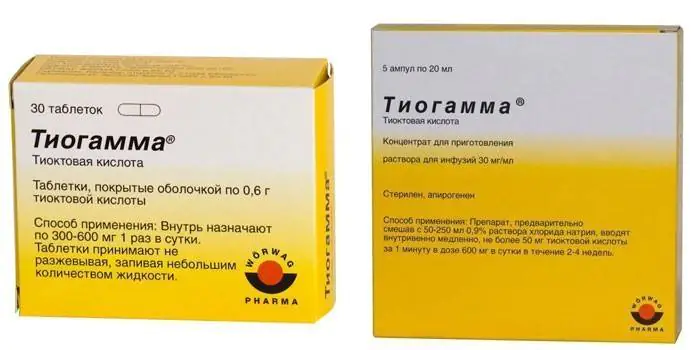
Indications for use
Thiogamma has indications for use due to the properties of the active substance of the drug. The main reasons for prescribing the drug:
- neuropathy due to diabetes;
- painful conditions of the liver: fatty degeneration processes of hepatocytes, cirrhosis and hepatitis of various origins;
- destruction of nerve trunks caused by alcohol;
- poisoning with severe symptoms (mushrooms, heavy metal salts);
- sensorimotor or peripheral polyneuropathy.
Directions for use and dosage
Depending on the form of the drug, the method of administration and dosage differ. It is especially important to follow the rules when using the solution and concentrate to prepare the solution. After removing the bottle from the box, it is necessary to immediately cover it with the included light-protective case (light has a destructive effect on thioctic acid). A solution is prepared from the concentrate: the contents of one ampoule are mixed with 50-250 ml of 0.9% sodium chloride solution. It is recommended to administer the drug immediately, the maximum storage period is 6 hours.
Thiogamma tablets
The tablets are taken once a day before meals at the dosage prescribed by the doctor; the tablets are not chewed and washed down with a small amount of liquid. The duration of the course of therapy is 30-60 days and depends on the severity of the disease. It is permissible to repeat the course of therapy two to three times during the year.
Thiogamma for IVs
When using the drug, it is important to remember to use a light-protective case after removing the bottle from the box. The infusion must be carried out at an injection rate of 1.7 ml per minute. When administered intravenously, it is necessary to maintain a slow pace (period of 30 minutes), a dosage of 600 mg per day. The course of treatment is two to four weeks, after which it is possible to continue taking the drug in oral tablet form at the same daily dosage of 600 mg.
For facial skin
The drug Thiogamma has found its application for facial care. For this purpose, the contents of dropper bottles are used. The use of this form is due to the optimal concentration of the drug. The drug in ampoules is not suitable due to the high density of the active substance, this can cause an allergic reaction. The solution from the bottles must be applied twice a day - morning and evening. Before use, you need to wash your face with warm water (possibly with lotion) to soften the pores and deep penetration of the active ingredient.

Special instructions
Among the sections of the instructions for use, the special instructions paragraph deserves close study. It contains rules and recommendations for using the drug:
- The medication is prohibited for use by patients with fructose intolerance, glucose-galactose malabsorption syndrome, and glucose-isomaltase deficiency.
- In case of diabetes mellitus, at the beginning of therapy, blood glucose levels should be carefully monitored; sometimes dose adjustment of insulin and other hypoglycemic agents is required. One tablet contains less than 0.0041 bread units.
- During treatment you should refrain from drinking alcohol. This reduces the therapeutic effect and may cause progression of neuropathy.
- During treatment, you can operate dangerous machinery and vehicles. The drug does not impair concentration and clarity of vision.
During pregnancy
Due to the content of active substances, the use of Thiogamma during pregnancy and lactation is prohibited. This is associated with a high risk of disruption of the vital functions of the fetus and the development of the infant or newborn. If it is impossible to stop using the drug during lactation, then it is necessary to stop or stop breastfeeding to avoid harm to the baby.
In childhood
The drug is prohibited for use by people under 18 years of age. This is due to the increased effect of thioctic acid on metabolism, which can lead to uncontrollable consequences in the body in children and adolescents. Before use, you should definitely consult a doctor and obtain permission after a thorough examination of your organs and systems.
Thiogamma for weight loss
Lipoic acid is an antioxidant, accelerates metabolic processes, improves the functioning of the pancreas, so it can be used for weight loss. It regulates sugar levels, slows down the aging process, improves blood flow, accelerates the process of converting carbohydrates into energy, and promotes the oxidation of fatty acids. The acid also blocks an enzyme in brain cells that is responsible for sending hunger signals, which helps control appetite.
As we age, the production of lipoic acid slows down, so it is used as a continuous supplement. The drug Tiogamma can be used for weight loss, but subject to regular physical activity. Nutritionists advise taking 600 mg of the active ingredient/day before or after breakfast, along with carbohydrates, after training or with the last meal. At the same time as taking it, you should reduce the caloric content of food consumed.
Drug interactions
Thioctic acid in Thiogamma enhances the anti-inflammatory effect of glucocorticosteroids. Other examples of drug interactions:
- The drug reduces the effectiveness of Cisplatin.
- The active substance binds metals, so the simultaneous use of iron, calcium and magnesium supplements is prohibited - at least two hours must pass between the use of these drugs.
- The medication enhances the effect of insulin and oral hypoglycemic agents.
- Ethanol and metabolites weaken the effect of the acid.
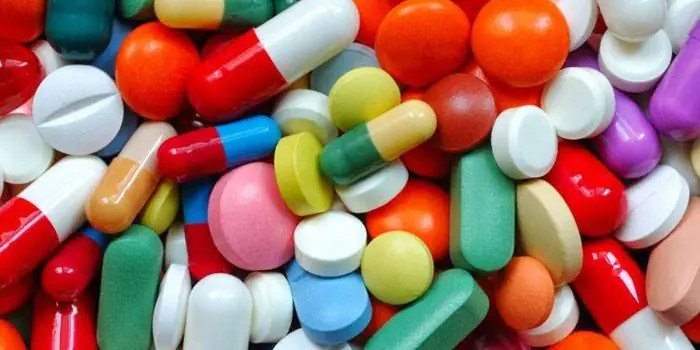
Side effects
While taking Thiogamma, various side effects may occur. The most common ones include:
- nausea, diarrhea, vomiting, stomach pain, hepatitis, gastritis;
- intracranial hemorrhage;
- respiratory disorders, shortness of breath;
- allergic reactions, anaphylactic shock, skin rash, itching, urticaria;
- disturbance of taste sensations;
- decreased concentration of glucose in the blood - hypoglycemia: dizziness, headache, increased sweating, blurred vision.
Overdose
Symptoms of an overdose of Thiogamma are headache, vomiting, nausea. Acute overdose is manifested by confusion, psychomotor agitation, generalized convulsions, and the formation of lactic acidosis. Sometimes shock, hemolysis, intravascular coagulation, and bone marrow suppression may occur. Taking 10-40 g of thioctic acid in combination with alcohol leads to multiple organ failure, intoxication, and death. There is no specific antidote; symptomatic therapy, analgesics, and injections are prescribed.
Contraindications
The drug is not prescribed during pregnancy, breastfeeding, children and adolescents under 18 years of age. Other contraindications for the use of the drug Tiogamma are:
- galactose intolerance;
- hepatitis, cirrhosis;
- epileptic seizures;
- lactase deficiency;
- glucose-galactose malabsorption;
- hypersensitivity to the components of the composition or thioctic acid.
Terms of sale and storage
You can buy the drug Thiogamma with a prescription; it should be stored in a dry place, inaccessible to children, at a temperature of up to 25 degrees for no more than five years.
Analogues of Thiogamma
Thiogamma substitutes include those drugs that contain the same active substance. Analogues of the drug:
- Lipoic acid is a tablet preparation, a direct analogue;
- Berlition – tablets and concentrated solution based on thioctic acid;
- Thiolepta - plates and solution for the treatment of diabetic, alcoholic neuropathy;
- Thioctacid turbo is a metabolic drug based on alpha-lipoic acid.
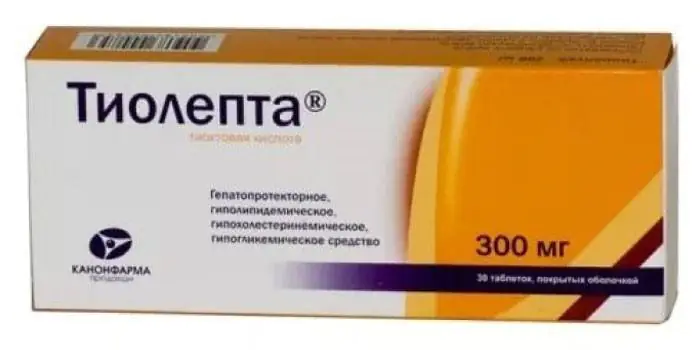
The cost of purchasing Thiogamma will depend on the chosen form of release of the drug, the amount of medicine in the package and the pricing policy of the retailer and manufacturer. Approximate prices for the product in Moscow:
Solution for infusion 150 ml
Tablets 600 mg, 30 pcs.
Tablets 600 mg, 60 pcs.
Solution for infusion 50 ml, 10 bottles
Reviews
Alla, 37 years old The drug Tiogamma was recommended to me by a friend who lost weight on it beyond recognition. She took it with the doctor’s permission, after training, and additionally limited her diet. I started taking pills and eating right, and lost five kilograms in a month. Excellent result, I think I will repeat the course more than once.
Alexey, 42 years old Due to my addiction to alcohol, I developed polyneuropathy, my hands were shaking, and I began to suffer from frequent mood swings. Doctors said that we must first recover from alcoholism, and then eliminate the consequences. At the second stage of therapy, I began taking Thiogamma solution. It effectively copes with the problem of neuropathy, I began to sleep better.
Olga, 56 years old I suffer from diabetes, so I have a tendency to develop neuropathy. Doctors prescribed the drug Thiogamma for prevention, and additionally adjusted the insulin dose. I take the pills according to the instructions and see changes - I have become much calmer, I no longer have cramps at night and in the morning, my hands do not shake from anxiety.
Larisa, 33 years old I heard advice from a friend in cosmetology: use lipoic acid in ampoules to eliminate age spots and incipient wrinkles. I asked the doctor to write out a prescription and bought it and used it in the evenings: after washing my face, I applied the solution instead of tonic, and then the cream on top. Within a month, the spots began to disappear, the skin became noticeably fresher.
Prices in online pharmacies:
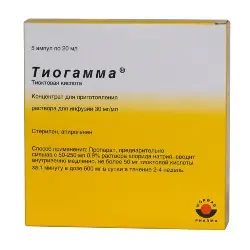
Thiogamma is a drug with antioxidant and metabolic effects; regulates carbohydrate and lipid metabolism.
Release form and composition
Thiogamma is available in the following forms:
- film-coated tablets: biconvex, oblong, light yellow with white or yellow inclusions of varying intensity, there are marks on both sides; the cut shows a light yellow kernel (10 pieces in blisters, 3, 6 or 10 blisters in a cardboard pack);
- solution for infusion: transparent, yellowish-green or light yellow liquid (50 ml in dark glass bottles, 1 or 10 bottles in a cardboard box);
- concentrate for preparing a solution for infusion: transparent yellowish-green liquid (20 ml in dark glass ampoules, 5 ampoules in cardboard trays, 1, 2 or 4 trays in a cardboard pack).
1 tablet contains:
- active ingredient: thioctic (alpha-lipoic) acid – 600 mg;
- auxiliary components: microcrystalline cellulose, croscarmellose sodium, simethicone, colloidal silicon dioxide, lactose monohydrate, talc, magnesium stearate, hypromellose;
- shell: talc, macrogol 6000, sodium lauryl sulfate, hypromellose.
1 ml of solution for infusion contains:
- active ingredient: thioctic (alpha-lipoic) acid – 12 mg (per 1 bottle – 600 mg);
- auxiliary components: macrogol 300, meglumine (to correct the pH value), water for injection.
1 ml of concentrate for the preparation of solution for infusion contains:
- active ingredient: thioctic acid – 30 mg (per 1 ampoule – 600 mg);
- auxiliary components: macrogol 300, meglumine (to correct the pH value), water for injection.
Indications for use
The drug Thiogamma is used to treat alcoholic and diabetic polyneuropathy.
Contraindications
- children and adolescents up to 18 years of age;
- pregnancy period;
- breastfeeding period;
- glucose-galactose malabsorption, lactase deficiency, hereditary galactose intolerance (for tablets);
- hypersensitivity to the main or auxiliary ingredients of the drug.
Directions for use and dosage
Film-coated tablets
The drug Thiogamma in tablet form is taken orally, on an empty stomach, with a small amount of liquid.
Recommended dose – 1 pc. (600 mg) once a day. The duration of therapy depends on the severity of the disease and ranges from 30 to 60 days.
During the year, the course of treatment can be repeated 2-3 times.
Solution for infusion, concentrate for the preparation of solution for infusion
The drug Thiogamma in the form of a solution is administered intravenously slowly, at a rate of about 1.7 ml/min for 30 minutes.
The recommended daily dose is 600 mg (1 bottle of solution for infusion or 1 ampoule of concentrate for preparing an infusion solution). The drug is administered once a day for 2–4 weeks. After which the patient can be transferred to the oral form of Thiogamma in the same doses (600 mg per day).
The drug in the form of a solution for infusion is ready for use. After releasing the bottle from the box, it is immediately covered with a special light-protective case to prevent light from reaching the thioctic acid, which is sensitive to its effects. Intravenous infusion is performed directly from the bottle.
When using Thiogamma in the form of a concentrate, you must first prepare an infusion solution. To do this, the contents of one ampoule of concentrate are mixed with 50–250 ml of isotonic sodium chloride solution. The prepared solution is immediately covered with a light-protective case. The infusion solution is administered immediately after preparation. Its storage duration is no more than 6 hours.
Side effects
Film-coated tablets
- digestive system: vomiting, nausea, diarrhea, abdominal pain;
- central nervous system: change or disturbance of taste;
- endocrine system: a decrease in the concentration of glucose in the blood and the resulting symptoms of hypoglycemia (headache, dizziness, visual disturbances, increased sweating);
- allergic reactions: urticaria, itching, skin rash, systemic reactions (up to anaphylactic shock).
Solution for infusion
- central nervous system: change or disturbance of taste, convulsions (up to epileptic seizures);
- organ of vision: bifurcation of visible objects;
- hematopoietic system: thrombocytopenia, thrombophlebitis, hemorrhagic rash, pinpoint hemorrhages in the skin and mucous membranes;
- skin and subcutaneous tissue: eczema, itching, rash;
- endocrine system: a decrease in the concentration of glucose in the blood and the resulting symptoms of hypoglycemia (headache, dizziness, visual disturbances, increased sweating);
- allergic reactions: urticaria, systemic reactions in the form of nausea, itching and discomfort (up to anaphylactic shock);
- reactions at the injection site: hyperemia, irritation or swelling;
- other reactions: difficulty breathing and increased intracranial pressure (with rapid administration of the drug).
special instructions
In patients with diabetes, especially at the beginning of drug therapy, blood glucose levels should be monitored. If necessary, doses of oral hypoglycemic agents and insulin are adjusted.
If symptoms of hypoglycemia appear, Thiogamma should be discontinued immediately.
During the treatment period, it is necessary to refrain from drinking alcohol-containing drinks, since alcohol reduces the effectiveness of the drug and is a risk factor for the development and progression of neuropathy.
One 600 mg tablet contains less than 0.0041 XE (bread units).
Direct use of Thiogamma does not affect the patient’s ability to drive vehicles or operate other potentially dangerous mechanisms. But it is necessary to take into account possible side effects from the endocrine system, due to a decrease in blood glucose levels, such as visual disturbances and dizziness.
Drug interactions
When thioctic acid is used together with glucocorticosteroids, their anti-inflammatory effect is enhanced; with cisplatin – the effectiveness of cisplatin decreases; with insulin or oral hypoglycemic agents - their effect may be enhanced; with ethanol and its metabolites - the effectiveness of thioctic acid decreases.
Thiogamma binds metals, so the drug should not be used together with medications containing metals (for example, magnesium, iron, calcium). There should be an interval of at least 2 hours between taking thioctic acid and these drugs.
The solution for infusion should not be mixed with Ringer's solution, dextrose solution and solutions that react with SH groups and disulfide groups.
Terms and conditions of storage
Store in a dry place at a temperature not exceeding 25 °C. Keep away from children.
The shelf life of the drug is 5 years.
Found an error in the text? Select it and press Ctrl + Enter.
| Rating 4.3/5 |
| Efficiency |
| Price quality |
| Side effects |
Thiogamma (Thiogamma): 8 doctor reviews, 3 patient reviews, instructions for use, analogues, infographics, 3 release forms.
Prices for thiogamma in Moscow pharmacies
| solution for infusion | 12 mg/ml | 50 ml | 10 pieces. | ≈ 1699 rub. |
| 12 mg/ml | 50 ml | 1 PC. | ≈ 222 rub. | |
| pills | 600 mg | 30 pcs. | ≈ 844.5 rub. | |
| 600 mg | 60 pcs. | ≈ 1595 rub. |
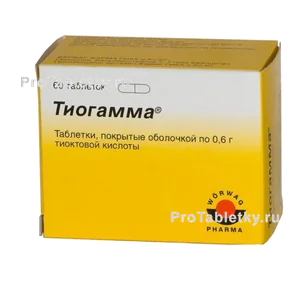
Reviews from doctors about thiogamma
| Rating 4.2 / 5 |
| Efficiency |
| Price quality |
| Side effects |
"Tiogamma" is a drug for restoring damaged nerve fibers. For pain in patients with alcoholic and diabetic polyneuropathies, it is ideal after a course of intravenous drip infusions. The course of treatment with tablets is 3 months, 2 times a year.
Patients tolerate it well. And the price is cheaper than the original drug. There was a patient with a side effect in the form of nausea from the original drug, but she tolerated Tiogamma perfectly, both in tablets and in infusions.
| Rating 5.0 / 5 |
| Efficiency |
| Price quality |
| Side effects |
Ideal price-quality ratio, convenient dosage regimen - 1 capsule 600 mg in the morning for 2 weeks.
Few doctors know the strengths of this drug, otherwise it would be used much more often.
Today, the best alpha-lipoic acid preparation for the treatment of neuropathies, neuritis and neuralgia of various origins.
| Rating 4.6/5 |
| Efficiency |
| Price quality |
| Side effects |
The drug "Tiogamma" in the form of an oblong tablet with a score in the middle is ideal for patients undergoing chemotherapy, due to severe intoxication during chemotherapy and the impossibility of prescribing many other restorative drugs. As an antioxidant, the drug "Tiogamma" helps eliminate free radicals.
There is a weak research base on the effects of the drug on children, as a result of which the instructions indicate that it is contraindicated for children.
| Rating 3.8/5 |
| Efficiency |
| Price quality |
| Side effects |
A high-quality preparation of thioctic acid. There is no need to prepare a solution for intravenous infusion. It is cheaper than imported drugs and is highly effective.
The cost of course treatment is still high.
An indispensable drug for the treatment of diabetic polyneuropathy, significantly slowing its progression. Significantly reduces the healing time of trophic ulcers in the complex treatment of diabetic foot syndrome.
| Rating 2.9/5 |
| Efficiency |
| Price quality |
| Side effects |
An excellent generic with antioxidant properties. Almost a “native” drug for people suffering from diabetes and polyneuropathy. Convenient form of use. There are no adverse drug reactions in practice.
If the price were even lower, it would be great.
I use it in clinical practice.
| Rating 4.6/5 |
| Efficiency |
| Price/quality |
| Side effects |
The effectiveness is close to the official drug. The only drug with the possibility of intravenous drip administration of 600 mg. in a ready-made bottle of 50 ml. Only 50 ml.! No need to dilute + comes with a dark bag to protect from light. Compliance 100%.
An excellent generic that has proven itself.
| Rating 4.6/5 |
| Efficiency |
| Price quality |
| Side effects |
The drug thioctic acid has found wide use in the treatment of polyneuropathies, diabetes mellitus, and toxic polyneuropathies (alcoholic), post-traumatic, postherpetic, as well as hepatic encephalopathies! Course therapy: initially, 10 courses of intravenous infusion, then transfer to tablet form for up to 1-1.5 months, 2-3 times a year.
| Rating 4.6/5 |
| Efficiency |
| Price quality |
| Side effects |
Excellent quality, different release forms. The presence of a bottle-shaped form is very convenient for patients with “bad” veins to reduce infusion time, or for hypertensive patients who do not want to inject a large volume of liquid.
Course treatment is quite expensive.
Well tolerated. Large niche for application. Various metabolic disorders can be compensated for. It is good both for damage to individual nerves (facial, ulnar, radial) and for multiple damage to nerve endings (for example, in patients with diabetes or alcoholism).
Patient reviews of thiogamma
I have been suffering from diabetes for thirty years. I vitally need this drug; every year I receive treatment with Tiogamma. Thanks to this drug, my wounds heal quickly, there are no ulcers on my feet, and the sensitivity of my limbs is normal. The price is, of course, high. After a bite of "Tiogamoy" you need to take "Thiolepta" in tablets; without tablets there is little benefit. After a month of treatment, your fingertips stop going numb, you begin to feel more energetic, you have more strength in your legs, and in general, your health improves.
I have been suffering from diabetes for a long time (21 years). Over time, unpleasant sensations began to appear in the lower extremities: muscles ached, a feeling of numbness in the feet sometimes, like goosebumps. I was prescribed a course of Thiogamma intravenously once a day for 10 days. Then I was prescribed pills for another two weeks (1 tablet 2 times a day). All symptoms disappeared and my legs stopped getting tired quickly. In general, I felt relief after 3 droppers. I take this course once a year.
My grandmother has had type 2 diabetes for many years. Atrophy of the lower extremities began. To restore muscle function, Thiogamma was prescribed. They gave me an intravenous course and then took the pills. My health has improved significantly. I began to walk a little. Pain sensitivity was restored.
Release forms
| Dosage | Packing | Storage | Sale | Best before date | |||||||
|---|---|---|---|---|---|---|---|---|---|---|---|
| 5; 10; 20 | 50 | 30, 60, 100 |
Instructions for use of thiogammaShort descriptionThe German drug thiogamma is a metabolic drug that controls the metabolism of lipids and carbohydrates and is used in the treatment of diabetic and alcoholic polyneuropathy (multiple lesions of areas of the peripheral nervous system). The pharmacologically active substance of the drug is thioctic acid. Diabetic polyneuropathy (polyneuropathy) is a typical complication of diabetes mellitus. It begins to manifest itself with numbness, burning and pain in the limbs at rest. Over time, this whole complex of unpleasant sensations gains intensity and begins to overwhelm the patient constantly. Polyneuropathy is characterized by movement disorders and reflex disorders. The first to become involved in the pathological process are thin sensory nerve fibers, the defeat of which entails a decrease or complete loss of temperature and pain sensitivity. Then comes the turn of thick nerve fibers, the “switching off” of which leads to disruption of proprioceptive (sensing the position of body parts relative to each other) and vibration sensitivity, inhibition of the spread of excitation. The “attack” of the disease on the motor nerves leads to atrophic changes in the small muscles of the foot and interosseous muscles, impaired muscle tone of the flexors and extensors of the fingers. The reason for such serious consequences of diabetes is prolonged and uncontrolled hyperglycemia. To prevent these complications, it is necessary to constantly maintain blood glucose levels within normal limits. But in addition to the pathogenetic therapy of diabetes, one cannot do without a symptomatic component, namely, the effect on damaged nerve fibers. In the treatment of diabetic polyneuropathy, the drug thiogamma based on thioctic acid, a coenzyme produced in the human body, has proven itself well. Thioctic acid provides transmembrane transport of glucose, participates in the process of formation of glucose from other compounds, thereby replenishing energy deficiency. Regulates the metabolism of carbohydrates and lipids, stimulates cholesterol metabolism, improves liver function. It has a hepatoprotective effect and reduces the amount of “bad” cholesterol. Improves nervous trophism. Reduces the level of free radicals (antioxidant properties). A number of studies have demonstrated the hypoglycemic properties of thioctic acid. In type 2 diabetes mellitus, the amount of thioctic acid synthesized in the human body is significantly reduced. Its lack negatively affects energy metabolism. In such situations, it is almost impossible to do without replenishing the deficiency of this substance from external sources, which is the drug thiogamma. The results of recent clinical trials of this drug indicate normalization of glutathione concentrations in peripheral nerves, which has a beneficial effect on their conductivity. In addition, while taking the drug, the signs of oxidative stress that develops under the influence of free radicals and developed endoneural hypoxia are leveled. Thioctic acid is able to dissolve in both water and lipids, which allows it to be active in aqueous and fatty environments and is rightfully considered one of the most powerful antioxidants. This compound accumulates in large quantities in peripheral nervous tissue, normalizing the blood supply to nerve fibers and increasing the speed of excitation. Thiogamma is a well-studied drug with a favorable safety profile. Its initial daily dose should be 600 mg. The treatment tactics are as follows: first, thiogamma is administered intravenously for 2-4 weeks, then they switch to using the drug in tablet form at a dose of 600 mg once a day. For preventive purposes, thiogamma is prescribed in tablet form to take 600 mg of the drug once a day for a long time. PharmacologyMetabolic drug. Thioctic (α-lipoic) acid is an endogenous antioxidant (binds free radicals), synthesized in the body during the oxidative decarboxylation of alpha-keto acids. As a coenzyme of mitochondrial multienzyme complexes, it participates in the oxidative decarboxylation of pyruvic acid and alpha-keto acids. Helps reduce blood glucose concentrations and increase glycogen content in the liver, as well as overcome insulin resistance. Participates in the regulation of lipid and carbohydrate metabolism, affects cholesterol metabolism, improves liver function, has a detoxification effect in cases of poisoning with heavy metal salts and other intoxications. It has hepatoprotective, hypolipidemic, hypocholesterolemic and hypoglycemic effects. Improves trophism of neurons. In diabetes mellitus, thioctic acid improves endoneurial blood flow, increases glutathione content to a physiological value, which ultimately leads to an improvement in the functional state of peripheral nerve fibers in diabetic polyneuropathy. PharmacokineticsAfter oral administration, thioctic acid is quickly and almost completely absorbed from the gastrointestinal tract. When taken simultaneously with food, absorption is reduced. Time to reach Cmax (4 mcg/ml) - about 30 minutes. Bioavailability - 30-60% due to the “first pass” effect through the liver. Metabolized in the liver by side chain oxidation and conjugation. Thioctic acid and its metabolites are excreted by the kidneys (80-90%), in small quantities - unchanged. T1/2 is 25 min. Release formFilm-coated tablets, oblong, biconvex, with a smooth and slightly shiny surface, with one dividing line on both sides, yellow in color with possible inclusions of white or dark yellow. |
| 1 tab. | |
| thioctic acid | 600 mg |
Excipients: hypromellose - 25 mg, colloidal silicon dioxide - 25 mg, microcrystalline cellulose - 49 mg, lactose monohydrate - 49 mg, carmellose sodium - 16 mg, talc - 36.364 mg, simethicone (dimethicone and colloidal silicon dioxide in a ratio of 94:6 ) - 3.636 mg, magnesium stearate - 16 mg.
Shell composition: macrogol 6000 - 0.6 mg, hypromellose - 2.8 mg, talc - 2 mg, sodium lauryl sulfate - 0.025 mg.
10 pieces. - blisters (3) - cardboard packs.
10 pieces. - blisters (6) - cardboard packs.
10 pieces. - blisters (10) - cardboard packs.
Dosage
Prescribed orally 600 mg (1 tablet) 1 time/day.
The tablets are taken on an empty stomach, without chewing, with a small amount of liquid.
The duration of treatment is 30-60 days, depending on the severity of the disease. The course of treatment can be repeated 2-3 times a year.
Overdose
Symptoms: nausea, vomiting, headache. In the case of taking from 10 to 40 g of thioctic acid in combination with alcohol, cases of intoxication, including death, have been observed.
Symptoms of acute overdose: psychomotor agitation or confusion, usually followed by the development of generalized convulsions and the formation of lactic acidosis. Cases of hypoglycemia, shock, rhabdomyolysis, hemolysis, disseminated intravascular coagulation, bone marrow suppression, and multiorgan failure have also been described.
Treatment: carry out symptomatic therapy. There is no specific antidote.
Interaction
Thioctic acid enhances the anti-inflammatory effect of GCS.
With the simultaneous administration of thioctic acid and cisplatin, a decrease in the effectiveness of cisplatin is observed.
Thioctic acid binds metals, so it should not be prescribed simultaneously with drugs containing metals (for example, iron, magnesium, calcium) - the interval between doses should be at least 2 hours.
With simultaneous use of thioctic acid and insulin or oral hypoglycemic drugs, their effect may be enhanced.
Ethanol and its metabolites weaken the effect of thioctic acid.
Side effects
The frequency of adverse reactions is given in accordance with the WHO classification:
| Often | more than 1 in 10 treated |
| Often | in less than 1 in 10 but more than 1 in 100 treated |
| Infrequently | in less than 1 in 100 but more than 1 in 1000 treated |
| Rarely | in less than 1 in 1,000 but more than 1 in 10,000 treated |
| Very rarely | less than 1 in 10,000, including isolated cases |
Very rare ( ® contraindicated during pregnancy and lactation (breastfeeding).
Use in children
special instructions
Patients with rare hereditary fructose intolerance, glucose/galactose malabsorption syndrome or glucose-isomaltase deficiency should not take Thiogamma ® .
Patients with diabetes mellitus during treatment with Thiogamma ®, especially at the beginning of therapy, need to monitor blood glucose levels. In some cases, it may be necessary to adjust the dose of insulin or oral hypoglycemic drug to avoid the development of hypoglycemia.
Patients taking the drug Thiogamma ® should refrain from drinking alcohol. Alcohol consumption during therapy with Thiogamma ® reduces the therapeutic effect and is a risk factor contributing to the development and progression of neuropathy.
1 tablet of Thiogamma ® 600 mg contains less than 0.0041 XE.
Impact on the ability to drive vehicles and operate machinery
Taking the drug Thiogamma ® does not affect the ability to drive vehicles or operate other mechanisms.



